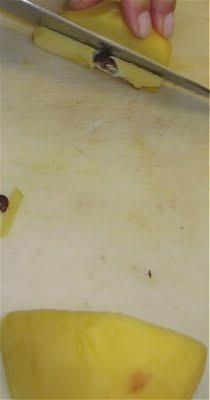
There is so much to be inspired by: a mind full of desire, the anticipation of a lover’s return, and a market bursting with a transitional bounty. As the seasons kiss each other hello and good-bye there remains remnants that are just holding on while their replacement starts filling the developing void.
I could have grabbed a pumpkin or snapped the first Brussels sprouts from their thick broccoli-like stalk. But no, I had to snag the last of the peppers, and cherry tomatoes knowing that an evening frost is but days away which will definitely seal the fate of my favorite summer blooms rendering my meals from the vibrant reds, oranges and yellows of August’s peak to the burnt amber and verdant greens of winter’s precursor.
While I am an admitted fan of the hot, sweltering dog days I do welcome the cool for it allows me to turn on my oven, once again, without fear that walls of my home will start to sweat. If only this was the depth of winter’s assault. So, with the motivation of an intimate dinner I set out to employ all the pleasures I had found. Using my alchemistic and culinary powers that I possess I wooed out delight for the joy of another.
Surf and Turf Pie – yields 4 servings
2-tablespoons canola oil
1-medium onion – peeled and sliced
1 red bell pepper – seeded, and cut into 1/2-inch pieces
2 poblano peppers – seeded, and cut into 1/-inch pieces
2-medium carrots – peeled, and cut into 1/4-inch pieces
1-pound smoked sausage – sliced into 1/2-inch rounds
1-pint cherry tomatoes - halved
1/4-cup chopped Italian parsley leaves
1-tablespoon chopped thyme leaves
1/4-cup chopped chives
1-teaspoon lemon zest
Pinch of saffron
2 1-1/4 pound lobsters
10-sheets phyllo
1/4-pound butter – melted
Heat a 10-inch sauté pan over a medium heat, and add the oil and onions. Cook the onions until lightly brown, and mix in the peppers, carrots and sausage. Continue to sauté the mixture for another five minutes. Remove from the heat, and mix the tomatoes, parsley, thyme, chives, lemon zest and saffron.
Place a skewer through the length of the lobster tail.

This will prevent it from curling when cooked.
In a 4-quart pan bring 4-cups of water to the boil, and add the lobsters. Cook the lobsters for 10 minutes.
Remove the lobsters from the water, and crack the shell of the claws and tail. Retrieve the meat from the lobster, and slice into large pieces. Mix into the sausage mixture.
Pre-heat the oven to 350-degrees.
Place the sausage mixture into a 10-inch quiche pan.

Lay a sheet of phyllo down on a clean work surface, and paint with the melted butter. Continue with another 4 sheets. Place the phyllo over the sausage mixture. Then repeat with the remaining five sheets of phyllo. Crimp and tuck the phyllo edge into the quiche pan. Paint the top of the phyllo with the melted butter.

Place in the oven, and bake for 45 minutes until golden.
Serve immediately.

 Hearing the roar
Hearing the roar































